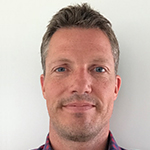European Society of Radiology: Could you please give a detailed overview of when and for which diseases you use cardiac imaging?
Thomas Skårup Kristensen:
- Suspected ischaemic heart disease (IHD, low to intermediate risk)
- Viability
- Suspected coronary anomalies
- Congenital heart disease
- Heart failure
- Cardiomyopathies
- Preoperative planning of TAVI (transcatheter aortic valve implantation)
- Preoperative planning in congenital heart disease
ESR: Which modalities are usually used for what?
TSK:
- Suspected ischaemic heart disease (low to intermediate risk)
- Coronary computed tomography angiography (CCTA) to rule out IHD
- Myocardial scintigraphy or MRI perfusion in equivocal cases. Ongoing research to validate adenosine perfusion CT
- Viability
- MRI, PET
- Suspected coronary anomalies
- CCTA
- Congenital heart disease
- MRI, US and CT for diagnosis – MRI for follow up
- Heart failure
- MRI for functional imaging, CCTA for ruling out ischaemic cause
- Cardiomyopathies
- MRI
- Preoperative planning of TAVI
- CCTA for sizing of valve and arterial access
- Preoperative planning in congenital heart disease
- Anatomical mapping – occasionally with a 3D-print
ESR: What is the role of the radiologist within the ‘heart team’? How would you describe the cooperation between radiologists, cardiologists, and other physicians?
TSK: This role varies throughout the country. Cardiac imaging (CT and MRI) is in most places primarily conducted by cardiologists and the radiologist examines extra-cardiac findings. In other institutions, radiologists and cardiologists perform a mutual evaluation, and in a few places, the imaging is performed by radiologists alone. PET imaging and SPECT imaging is performed by nuclear medicine physicians.
ESR: Radiographers/radiological technologists are also part of the team. When and how do you interact with them?
TSK: We have dedicated radiographers for cardiac imaging with a very high expertise. We have a very close collaboration for setting up protocols and ongoing quality assessments. For routine examinations, there is no involvement from the doctors. For patients with complex anatomy (congenital heart disease), in children or when IV-medications is needed (beta-blocker, adenosine) a doctor is present in the scanner-suite.
ESR: Please describe your regular working environment (hospital, private practice). Does cardiac imaging take up all, most, or only part of your regular work schedule? How many radiologists are dedicated to cardiac imaging in your team?
TSK: I work as a radiologist in a tertiary hospital. The number of ‘rule-out-IHD’ patients is thus quite low. I am the only radiologist working directly with cardiac imaging – usually in more complex patients. My colleagues in the radiology department are all involved in evaluating extra-cardiac findings.
In addition, I service the Department of Radiology in Greenland. In this remote population, we perform CCTA on an unselected group of patients with chest pain (both typical angina and atypical chest pain). The images are sent to Denmark, and I return my description by e-mail.
ESR: Do you have direct contact with patients and if yes, what is the nature of that contact?
TSK: The cardiologists are responsible for the contact with the patients.
ESR: If you had the means: what would you change in education, training and daily practice in cardiac imaging?
TSK: With the right resources I could hope that radiologists would be more directly involved in cardiac imaging and not just extra-cardiac findings. As of now, there is no routine education in cardiac imaging and radiologists working with cardiac imaging are usually attending international courses/fellowships.
ESR: What are the most recent advances in cardiac imaging and what significance do they have for improving healthcare?
TSK: The very low radiation doses, and high diagnostic accuracy (high image quality due to improved temporal and spatial resolution). This means that we can detect disease and initiate the proper treatment at an earlier stage and hence reduce the risk of cardiovascular disease and mortality.
ESR: In what ways has the specialty changed since you started? And where do you see the most important developments in the next ten years?
TSK: As mentioned – the development in radiation dose and image quality has been tremendous. Future aspects, especially in cardiac CT, would be the further development of functional tools like for instance perfusion-CT, CT-fractional flow reserve, spectral imaging, plaque imaging.
ESR: Is artificial intelligence already having an impact on cardiac imaging and how do you see that developing in the future?
TSK: I have no personal experience with AI or machine learning, but I expect it to have a great impact on not only cardiac imaging, but all subspecialties in radiology.
 Dr. Thomas Skårup Kristensen is a radiologist at Rigshospitalet and associate professor at Copenhagen University in Copenhagen, Denmark.
In close collaboration with the Department of Cardiology, he implemented cardiac CT at Rigshospitalet, Copenhagen in 2005. He has since been involved in several projects in cardiac imaging research and has authored or co-authored 24 papers. In addition, he is an active teacher on several cardiac imaging courses. He is a member of several advisory boards under the Danish Health Authority concerning the use of cardiac imaging.
Dr. Thomas Skårup Kristensen is a radiologist at Rigshospitalet and associate professor at Copenhagen University in Copenhagen, Denmark.
In close collaboration with the Department of Cardiology, he implemented cardiac CT at Rigshospitalet, Copenhagen in 2005. He has since been involved in several projects in cardiac imaging research and has authored or co-authored 24 papers. In addition, he is an active teacher on several cardiac imaging courses. He is a member of several advisory boards under the Danish Health Authority concerning the use of cardiac imaging.